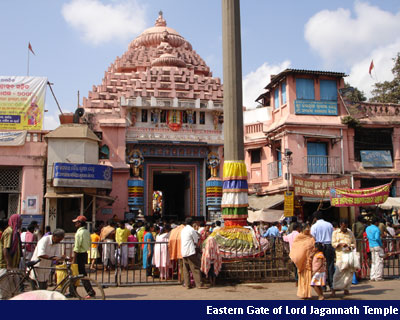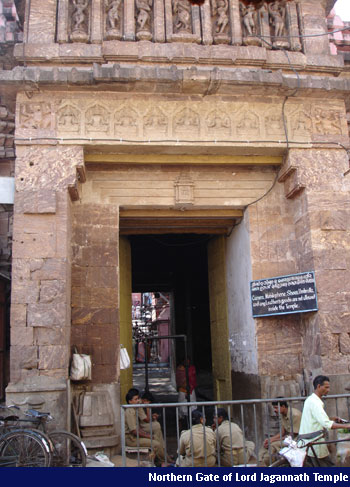

Loading Section...
The Lord Jagannath Temple has two big walls and four gates both in outer and inner walls. The outer wall of the temple is known as Meghanad Prachir (665 ft x 640 ft) and the inner wall is known as Kuruma Prachir (420 ft x 315 ft). The height of the outer wall varies from 20 ft to 24 ft with serrated battlement on its top and thickness is 6 ft. The height of Kuruma Prachir is almost equal to the height of Meghanad Prachir but the thickness of the wall is less than the thickness of Meghanad Prachir i.e only 5 ft. The loftiness of the outer walls proves that the temple had served the purpose of a fort. This is corroborated by the fact that at the time of the Muslim invasions the civilians as well as the soldiers took shelter inside the compound.


The four gates in outer walls are represented by four animals. The four gates are:
They are also called as Purba Dwara (Eastern Gate), Dakhina Dwara (Southern Gate), Paschima Dwara (Western Gate) and Uttar Dwara (Northern Gate) according to their directions. It is believed that Simha Dwara represents Dharma (piety), Ashwa Dwara represents Jnana (knowledge), Hasti Dwara represents Aishwarya (prosperity) and Vyaghra Dwara represents Vairagya (renunciation). Another interpretation depicts the East Lion's Gate as Mokshya Dwara, West Tiger Gate as Dharma Dwara, South Horse Gate as Karma Dwara and North Elephant Gate as Artha Dwara. There are pyramidal structures over the four gates. Worshipping the gates also forms a part of the daily ritualistic service of the temple.

1. Eastern Gate/Purba Dwara/Lion's Gate/Simha Dwara/Mokshya Dwara
The Simha Dwara or the Lion's Gate has on each side a colossal crouching lion of the usual Odishan make with a crown on its head, which gives the gate its name. At the entrance of the Lion's Gate on the northern side there is the image of Patitapavana. In front of Patitapavana, a small image of Garuda has been installed. The idols of Phate Hanuman, Radha-Krishna, and Nursimha have been installed on the side walls of the entrance. Formerly the untouchables who were not allowed to go inside the temple used to offer their prayers to Lord Patitapavana (representative of Lord Jagannath) remaining outside the Simha Dwara.


After the entrance, there are 22 flights of steps, known as Baisi Pahacha, from the eastern gate of the outer enclosure to the inner enclosure (known as Kuruma Bedha). The width of the middle 15 steps varies from 5 feet and 10 inches to 6 feet 3 inches and the rise is 6 inches to 7 inches. The size of the remaining 7 steps is smaller both in length and width. The steps are made of Khondalite. The idols of Kasi Biswanath, Ramachandra, Nursimha and Ganesh have been installed on the southern side of the Baisi Pahacha.
During the Car Festival, the idols of Jagannath, Balabhadra, Subhadra & Sudarshan are taken out of the temple through this gate. During the return Car Festival, as per the ritual, Lord Jagannath conciliates Goddess Laxmi, installed atop the doorway of this gate, to allow him to enter the temple. This statue of Goddess Laxmi is known as Torana Laxmi.

2. Southern Gate/Dakhina Dwara/Horse Gate/Ashwa Dwara/Karma Dwara
At the Ashwa Dwara or the Horse Gate there are two galloping horses, on each side, with Jagannath and Balabhadra on their back in the martial glory. These sculptures depict the legendary Kanchi expedition of Jagannath and Balabhadra. The inner enclosure is approached by ten flights of steps, made of khondalite, from the southern gateway of the outer enclosure. Towards the eastern direction of the steps, is the temple kitchen of Lord Jagannath which can feed thousands of people at a time.


The images of Sadhabhuja Gouranga, Ramachandra, Gopala, Bara-bhai Hanumana and Nursimha have been installed in small shrines in the outer enclosure. The colossal image of Mahavir Hanuman is installed outside the temple enclosure to the east of Ashwa Dwara.
3. Western Gate/Paschima Dwara/Tiger Gate/Vyaghra Dwara/Dharma Dwara
The Vyaghra Dwara or the Tiger Gate has on each side a figure of a tiger made of mortar. The inner enclosure is approached by seven flights of steps, made of khondalite, from the western gateway of the outer enclosure. The deities of Rameswar Mahadeva, Sri Jagannath, Dwarakanath and Badrinath are installed in the outer enclosure in a shrine known as Chaturdham.

On the southern side of the approaching steps towards inner enclosure, flower garden (Nilachala Upavana) of the temple is located from where flowers are collected for the daily worship of the deities. The shrines of Chakranarayana, Sidheswara, Mahavir Hanuman, and Dhabaleswar Mahadev are located in this area. On the northern side, the Niladri Vihar Museum has been constructed which depicts the popular legends on Lord Jagannath through models and paintings.
4. Northern Gate/Uttar Dwara/Elephant Gate/Hasti Dwara/Artha Dwara
The Hasti Dwara or the Elephant Gate had on each side a colossal figure of elephant, which is said to have been disfigured during the Muslim inroads. Subsequently, these figures were repaired and plastered with mortar and placed at the northern gate of the inner enclosure (Kuruma Bedha).

The inner enclosure is approached by thirteen flights of steps made of khondalite, from the northern gateway of the outer enclosure. The deities of Lokanath, Uttarani, Lakshmi-Nursimha, Varaha and Sitala have been installed in the outer enclosure. There is also the sacred Suna-Kua (Golden Well) from which 108 pitchers of water are taken for the ceremonial bath of Lord Jagannath during the Snana Yatra. On the western side of the outer enclosure, near the gate of the kuruma bedha, stands a banian tree, and on a raised platform, the famous Koili Baikuntha or Kaivalya Baikuntha. During the Nabakalebara, the images of Jagannath, Balabhadra and Subhadra are being constructed here. The logs of wood to make the new Deities make their entry to the temple premises through this gate.
The Sun Pillar/Aruna Stambha
In front of the entrance to the eastern gateway (Lion's Gate) of Lord Jagannath temple
there is the beautiful Sun Pillar (Aruna Stambha), which originally stood before the
Sun temple of Konark and was shifted here by the Marathas. The Sun Pillar is a monolithic
shaft of chlorite. It stands on an exquisitely carved pedestal and has a capital on the top,
over which squats the praying Aruna.
More information on Sun Pillar/Aruna Stambha.

| Content Navigation | ||
| Last Page | ||
|
||
| Next Page | ||
|
Loading Section...
Loading Section...